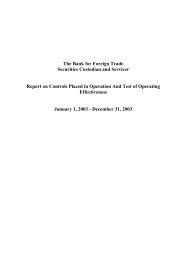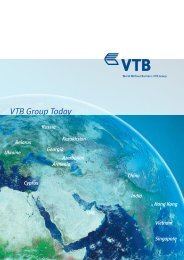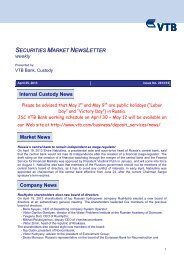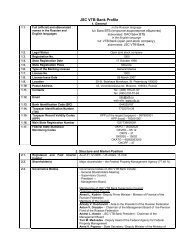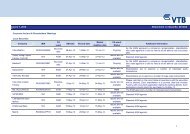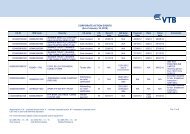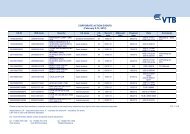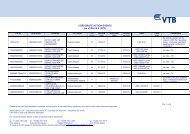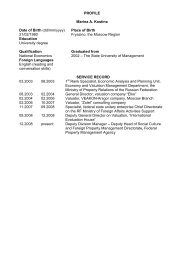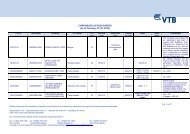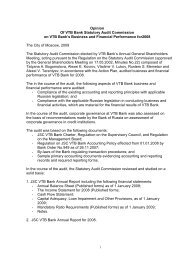Annual report 2011 - VTB
Annual report 2011 - VTB
Annual report 2011 - VTB
- No tags were found...
Create successful ePaper yourself
Turn your PDF publications into a flip-book with our unique Google optimized e-Paper software.
<strong>VTB</strong> BankNotes to the Consolidated Financial Statements – 31 December <strong>2011</strong> and 2010(in billions of Russian Roubles)5. Summary of Principal Accounting Policies (continued)Financial liabilitiesFinancial liabilities in the scope of IAS 32 and IAS 39 are classified as either financial liabilities at fair value throughprofit or loss, or other financial liabilities, as appropriate. The Group determines the classification of its financialliabilities at initial recognition. When financial liabilities are recognized initially, they are measured at fair value, minus,in the case of financial liabilities not at fair value through profit or loss, directly attributable transaction costs. Otherfinancial liabilities are carried at amortized cost using the effective interest rate method.Financial liabilities of acquired subsidiaries are initially recorded in the statement of financial position at theirestimated fair value at the date of acquisition.Financial liabilities are classified as financial liabilities at fair value through profit or loss if they are issued for thepurpose of repurchasing them in the near term. They normally contain trade financial liabilities or "short" positions insecurities. Derivatives with negative fair value are also classified as financial liabilities at fair value through profit orloss. Gains or losses on financial liabilities at fair value through profit or loss are recognized in the income statement.The fair value of financial liabilities, classified as financial liabilities at fair value through profit or loss, that are activelytraded in organized financial markets is determined by reference to quoted current ask prices. For financial liabilitiesclassified as financial liabilities at fair value through profit or loss, where there is no active market, fair value isdetermined using valuation techniques. Such techniques include using recent arm’s length market transactions,reference to the current market value of another instrument, which is substantially the same, discounted cash flow(net present value) analysis, option pricing models and other relevant valuation models.Derecognition of financial liabilitiesA financial liability is derecognized when the obligation under the liability is discharged or cancelled or expires. Wherean existing financial liability is replaced by another from the same creditor on substantially different terms, or theterms of an existing liability are substantially modified, such an exchange or modification is treated as a derecognitionof the original liability and the recognition of a new liability, and the difference in the respective carrying amounts isrecognized in the income statement.When a financial liability is repurchased (bought-back) by a certain Group member, it is derecognized. The differencebetween the carrying value (amortized cost) of a financial liability as of the date of buy-back and the considerationpaid is recognized in the income statement as the gain or loss arising from extinguishment of liability.OffsettingFinancial assets and liabilities are offset and the net amount is <strong>report</strong>ed in the statement of financial position whenthere is a legally enforceable right to set off the recognized amounts and there is an intention to settle on a net basis,or to realize the asset and settle the liability simultaneously.Cash and cash equivalentsCash and cash equivalents are items, which can be converted into cash within a day. All short-term interbankplacements, including overnight placements, are included in due from other banks. Amounts, which relate to fundsthat are of a restricted nature, and correspondent accounts in precious metals are excluded from cash and cashequivalents. Cash and cash equivalents are carried at amortized cost, which approximates fair value.Mandatory reserve deposits with central banksMandatory reserve deposits with the CBR and other central banks are carried at amortized cost and represent noninterestbearing deposits, which are not available to finance the Group’s day-to-day operations and hence are notconsidered as part of cash and cash equivalents for the purposes of the statement of cash flows.Due from other banksAmounts due from other banks are recorded when the Group advances money to counterparty banks with nointention of trading the resulting receivable, which is due on fixed or determinable dates. Amounts due from otherbanks are carried at amortized cost less allowance for impairment.16



